Home → Fish & Wildlife → Wildlife → Species Information → Mammals → Black Bears
Black Bears
Ursus americanus
On this page:
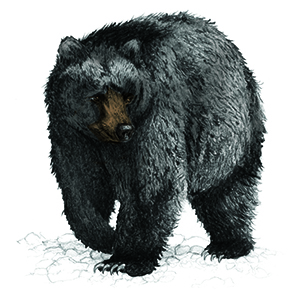
Habitat

Black Bear Range Map
The black bear is the smallest of the three species of bears inhabiting North America (black, brown/grizzly, and polar), has the widest distribution on the continent, and is the only bear living in the eastern United States. Black bears are found at varying population levels in approximately 40 states, occupying forested areas from Mexico north to the edge of the tree line in Canada and Alaska. In Maine, black bears are found nearly statewide, but are most common in northern, northwestern and eastern Maine and are less commonly found in the heavily settled southern and central-coastal regions.
Black bears utilize a variety of habitat types for protection and food, including forested areas, wetlands, and shrub/early successional habitats. However, they are also adaptable to human presence, and are able to survive in close proximity to housing developments and suburban areas wherever nearby habitat exists. Maine has abundant bear habitat, consisting of mostly second-growth conifer-deciduous forest that provides a variety of food resources (berries, nuts, fruits, and carrion).
Diet
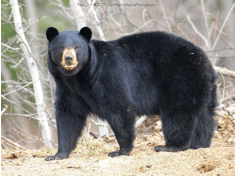
Photo Credit: Paul Cyr
Bears are opportunists and feed on a wide range of vegetation and animal matter. Although bears eat meat, their diet is primarily vegetarian, including early greening grasses, clover, and the buds of hardwood trees in the spring, fruits and berries in summer, and beechnuts, acorns, and hazelnuts in the fall. This diet is supplemented with insects, including ants and bees (their larvae, adults, and honey), and occasional mammals and birds. Bears are not considered efficient predators, but they are known to opportunistically prey on young deer and moose in late spring, and will consume carrion (animal carcasses) and occasionally kill livestock.
Bears are intelligent, and can rapidly adapt to new food sources, including agricultural crops, food placed to attract other wildlife such as bird feeders, and unsecured garbage. Therefore, conflicts between bears and farmers, beekeepers, orchardists, campers, and rural residents in the State can occur. See our Living with Wildlife page to learn more about how you can minimize conflicts with bears.
Bear feeding habits and needs vary with the seasons. During the fall, bears are feeding intensively to build fat stores for surviving a winter of fasting. Fall foods are especially important to reproductive age female black bears who need sufficient fat stores for fetal development and milk production. Spring represents a period of food stress, as most bears emerge from the den when limited natural food sources are available.
Distinctive Characteristics
The weights of black bears can vary tremendously across seasons. Bears store body fat during the fall months to supply energy during their long winter denning period, and are heaviest in late fall.
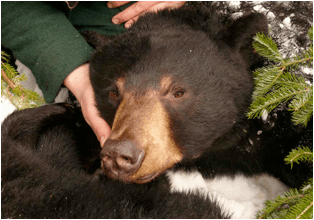
Photo Credit: Dominic Grenier
In Maine, adult males average 250 pounds, and measure 5-6 feet from tip of nose to the tip of their tail. Females are smaller, with adult females averaging 150 pounds, and measuring 4-5 feet in length. Males stand about 40 inches tall at the shoulder while females seldom exceed 30 inches. Bears are compact, with stocky legs, small eyes, short, rounded ears, short, curved claws, and a short, inconspicuous tail. The black bear has a straight facial profile and a massive skull. Black bears in Maine are normally black, but occasionally have a brownish coat. They have a brown muzzle, and occasionally a white throat or chest patch or "blaze". Bears walk flat-footed, and their broad feet leave 5-toed tracks that sometimes resemble human footprints. Tracks of female bears rarely exceed 4.5 inches in width; males leave tracks up to 6 inches wide.
Activity Patterns
Black bears can be active during the day or night and their activity patterns are often influenced by human activity, weather and temperature, food availability, and season. Black bears spend most of their time locating and consuming seasonal food resources, especially going into the fall, in preparation for winter denning.
Seasonal Changes
Black bear habitat use, movement patterns, and activity patterns vary depending on the season. In winter, black bears enter a state of torpor in their winter dens, lowering their metabolism and body temperature moderately to conserve energy and resources. During this time, they do not eat or drink, and live off of their fat reserves from the fall. When spring arrives, bears emerge from dens and seek out early spring vegetation, typically found in lowland and wetland areas. During the summer, bears seek out soft mast like raspberries, blackberries, and blueberries typically growing in more open habitats. And during the fall, bears shift to seeking out hard mast like acorns and beechnuts in forested areas, and other available soft mast. They consume around 20,000 calories per day during this period of excess eating (referred to as hyperphagia) in preparation for denning again in the winter. Black bears are generally solitary animals outside of breeding season and cub rearing. Adult females may be accompanied by cubs of the year or their yearlings.
Reproduction & Family Structure
Black bears breed from May through August, with most breeding activity peaking in June and July. Throughout the summer, males travel over large areas to enhance their chances of encountering mates. Although males become sexually mature at 1-2 years of age, most do not participate in breeding until they have reached full adult size, at about 4-6 years in Maine. Female bears in Maine become sexually mature between 3-5 years of age.
Although black bears breed in the summer, fetal development is delayed (through delayed implantation) until late fall/early winter, after the female has entered a den. After an approximately 60-day gestation period, female bears give birth to 1-4 cubs inside the winter den in January. If a female is unable to store sufficient body fat prior to entering the den, the fertilized egg is reabsorbed before fetal development.
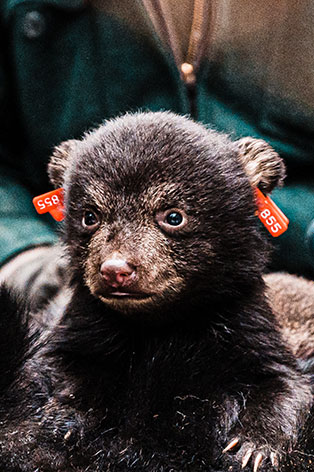
Cubs weigh about 12 ounces at birth and depend on their mother for warmth and nutrition during the remainder of the winter. They grow to 4-10 pounds by mid-April, when the mother leads them away from the protection of their winter den. Cubs remain with their mother through the summer and fall learning to forage and escape threats. In late fall, cubs enter dens with their mother and enter a state of torpor (lowering their body temperature and slowing their metabolism to conserve energy) and live off of their summer and fall fat reserves. When they emerge from their winter den as yearling bears, they remain with their mother until she goes into estrus in the spring/early summer. Female bears produce young every other year due to this long period of parental care which increases a cub's chance of survival. When beechnuts were the primary fall food for bears in northern Maine, most cubs were born in odd-numbered years in response to alternating years of high beechnut crops. Cub production has been more consistent in central Maine, where more stable fall food supplies result in nearly half of adult females giving birth each year. More recently,following several decades of decreased but consistent beechnut crops in northern Maine, cub production is less synchronized with beechnut production and about half of adult females give birth each year.
Survival & Threats
Bears are long-lived animals, capable of surviving 30 or more years in the wild. Their survival increases as they mature. About a third of newborn cubs die before reaching their first birthday, with starvation or predation being a major cause of death. Survival of adult bears in Maine exceeds 70% for males and 80% for females, and nearly all deaths of adult bears are due to hunting or other human-related causes. Hunting is highly regulated to manage the population at a healthy level, additional information about management goals can be found below.
Management & Conservation
Historic Management
A reassessment of the past, present, and future status of bears, their habitat, and demands on bears as a wildlife resource was completed in 1999. This assessment provides the scientific basis for deriving management goals. In 2001, the Department set new management goals and objectives to direct bear management through 2015 based upon the input and recommendations of a public working group representing diverse interests. A bear management goal of providing continued hunting, trapping and viewing opportunity for bears was established by 1) stabilizing the bear population's growth by 2005 at no less than current (1999) levels, 2) creating information and education programs to promote traditional hunting and trapping methods as preferred and valid tools to manage the state's black bear population, and 3) creating information and education programs to promote public tolerance of bears.
Current Management
In 2017, MDIFW entered another planning period to update management goals for Maine's game species, including black bears. The 2017 Big Game Management Plan (BGMP) identified three primary management goals for black bear management in Maine: 1) maintain a healthy, sustainable bear population overall, while minimizing population growth in areas of higher human density, 2) provide opportunities for the public to safely enjoy bears, and 3) increase public understanding of bear ecology, public support for bear management, and public tolerance for coexisting with bears. Following the development of the BGMP, in 2019, the Department worked with university partners to develop an integrated age-at-harvest population model (IPM), to better inform bear management in Maine. This model produces a more rigorous population estimate by integrating a variety of data including data on the age structure of Maine's bear population from teeth submitted by hunters, other harvest data, and survival and reproductive data collected through long-term monitoring of bears in three study areas. This model is updated regularly with current information from monitoring bear harvest and populations. Since 2008, Maine's bear population has remained fairly stable and is currently estimated to be around 25,000 bears with some variation.
Hunting
Black bears that were once bountied were granted game species status in 1969, and since that time there has been monitoring of annual harvests. Since 1990, Maine's bear season framework has remained fairly constant with a three-month fall hunting season that opens the last Monday in August and closes the last Saturday in November. The annual bag limit increased in 2008 to two bears per year with one taken by hunting and one by trapping. Bears can be hunted over bait during the first four weeks of the season, with hounds for a six-week period that overlaps the last two weeks of the bait season, and by still hunting and stalking throughout the entire season. In September and October, trappers can set one trap (either a cable foot restraint or cage-style trap) for bears. Harvest regulations are applied uniformly statewide, with no regional controls on hunting effort.
Bear hunting effort and success is estimated from annual permit sales, which fluctuate with changes in permit cost, gas prices, other economic factors, and ballot initiatives related to hunting and trapping. Since 1990, any hunter interested in harvesting a black bear has had to purchase a bear hunting permit in addition to their hunting license. Additionally, since 2008, trappers and non-resident deer hunters have been required to purchase a permit to harvest a black bear. This new permit was established to track hunter participation later in the season and to generate a dedicated funding source for bear research and management.
Permit fees influence bear hunter participation or willingness to purchase a permit. When permit fees are low, some hunters may purchase a permit for the potential opportunity to hunt bear, and when fees are higher, hunters are more likely to purchase a permit only if they seriously plan to hunt. Participation and permit sales increased around two bear hunting referendums in 2004 and 2014, and again following the Covid-19 pandemic years when general interest in outdoor recreation activities, including hunting and trapping, increased.
Historically, most bear permits (55-60%) were purchased by residents. However, following the closure of the Ontario spring bear hunt in 1999, nonresidents became more interested in hunting Maine black bears and since 2000, nonresidents have accounted for an average of 53% of bear hunting permits.
Today, approximately 11,300 (average) hunters and trappers purchase a bear permit each year in Maine. In addition, the nearly 200,000 resident hunters can harvest a bear while deer hunting. Less than 100 bears are taken by deer hunters each fall.
Research and Monitoring Program
To meet management objectives of maintaining a stable bear population, we must have a good understanding of the number of bears entering the population (cubs that survive to independence) to replace losses (bears that die due to natural factors and hunting). While the number of bears harvested by hunters each year is known, the number dying from other causes and the numbers entering the population is determined by our research.
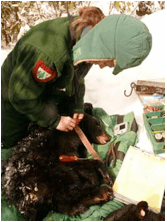
Photo Credit: Dominic Grenier
The Maine black bear monitoring program is a long-term project designed to gather these data. The program began in 1975 when Roy Hugie (with the University of Maine, in cooperation with the Department) established two study areas consisting of four townships each - Spectacle Pond (20 miles West of Ashland) and Stacyville (near Patten). For his PhD, Hugie compared population characteristics of the bears living in two areas that represented areas of different hunting pressure. At that time, the Spectacle Pond study area was lightly hunted, whereas bears in the Stacyville area experienced heavier hunting pressure. Today, hunting pressure is more evenly distributed across the primary bear range in Maine.
In 1981, the Department took over Hugie's project and established a third study area near Bradford in 1982. The Department also changed the focus of the project to monitoring radiocollared females bears in study areas with different habitat. These bears would represent bears living in similar habitats across the state. For example, if the radio-collared females in the northern commercial forest successfully raised cubs in a particular year, it was assumed that other females in the same type of habitat experienced similar success in other parts of the state.
In 2004, the Stacyville study area was discontinued, and a new study area was created in Downeast Maine (northeast of Beddington). This study area was established to address a longstanding need to better represent a portion of Maine's bear population in eastern Maine living under habitat conditions not well represented by the other study areas.
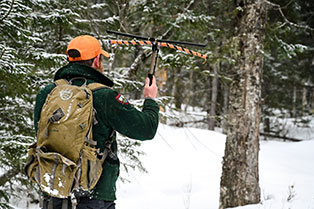
Currently, we have three active study areas in northern, north-central, and eastern Maine. Between 50 and 100 radiocollared female bears are monitored each year across all three study areas (with a goal of ~20 bears per study area in recent years). Radiocollars (some also having GPS capabilities) are helpful for monitoring black bears because their secretive nature makes them difficult to observe. Radiocollars send out a signal revealing each bear's location in her den as she hibernates under the winter snow, allowing biologists and pilots to locate their dens each winter. By visiting the dens of radiocollared female bears, Department biologists can determine the proportion of females with young, and the number of cubs born each year. Because cubs stay with their mother for 16 months and den with her the following winter, we can also determine how many cubs survive to one year of age (known as yearlings).
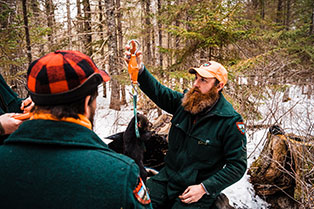
We have found differences in reproduction, survival, and recruitment between study areas as well as within study areas over time as habitat and weather conditions change. Nutrition plays a major role in determining the number of cubs that are produced, and cub survival through their first year.
Bears in Maine utilize a wide assortment of natural foods, and the food types that are available in each study area differ. For example, in northern Maine, beech trees provide the most reliable nut crop and beechnut production has been linked to cub production. However, these nuts have been less reliable in recent years (in part due to forest pests leading to beech bark and leaf diseases) and are less important in southern areas where there are oak trees. The abundance of many types of bear foods are affected by weather, which can make predicting the food supply and cub production difficult from year-to-year. Measurements of cub production, survival, and yearling weights during our winter den visits gives insight into food production during the previous year. For example, in winters following high productivity of fall foods, yearling bears weigh more in the den compared to winters following poor fall food production.
Forestry practices, forestland ownership, and market conditions are continually evolving, which can change the world the bears live in and the foods they depend on. Disease or insect outbreaks may influence forest composition and harvest strategies in the future. The combined effects of all these complex variables on bears are most easily measured by continually monitoring the bears' successes and failures directly in their dens.

A large part of our bear monitoring program involves capturing and radiocollaring bears in late spring and early summer, and allows us to collar new bears to replace those that have died or have been lost due to malfunctioning collars. While only female bears are collared to collect reproductive data, every bear we handle is marked with ear tags to be identified if encountered in the future. Because bears can damage or lose their ear tags (especially male bears damaging their ears while fighting), or lose their collars, we also tattoo their inner lip for a permanent mark. These marked individuals offer additional information regarding bear movements and mortality when bears are re-encountered through hunter harvest, roadkill or our own research efforts.
We have learned a lot about bears in Maine over the last 50+ years and continue to expand our knowledge by utilizing new tools and technology and partnering with other researchers. The Department's bear monitoring program is an ongoing source of information providing biologists with the information necessary to properly manage this valuable wildlife resource.
This work is possible thanks to a federal tax on firearms, ammunition and other hunting related items. The funds from this federal tax (known as Pittman-Robertson funds) pay for about 75% of the cost of the program. The remaining 25% comes primarily from hunting and fishing license sales.
Living with Wildlife
Prevent or Resolve Conflicts with Bears
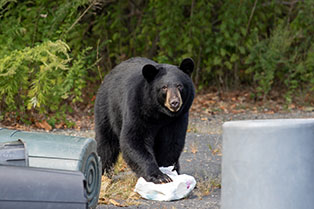
Black bear management is a balancing act between maintaining a healthy and abundant population, and limiting the growth of the bear population especially in more populated areas so that human-bear conflicts remain manageable.
Over the past century, conflicts between bears and humans in Maine have lessened with changes in agricultural practices, the decline of farming, increased interest in bear hunting, and the species' rise in status as a game animal. In addition, Maine has a small human population (1.4 million) that is mostly concentrated in the southern third of the state where bear densities are lower and therefore human-bear conflicts are less numerous. However, each year, primarily in the spring and early summer, the Department receives numerous calls from homeowners when bears have destroyed bird feeders or disturbed garbage or caused other damage. A big part of managing conflicts with bears involves modifying human behavior to lessen the number of negative interactions. Most conflicts with bears can be prevented by removing common food attractants around homes.
To prevent conflicts with black bears each year when bears are active (April 1-November 1):
- Bring in your bird feeders, rake up and dispose of any seed left on the ground, and store unused seed inside.
- Bring trash to the curb on the morning of trash pickup or use a certified bear resistant container.
- Keep dumpster lids closed and do not allow dumpster to overflow. In areas experiencing bear problems consider storing dumpsters in a secure building or behind electric fencing (MS Word).
- Clean your grills and empty the grease cup after each use. Do not discard grease on the ground. Burn-off any food residue, clean blood and grease dripping, and discard food wrappers.
To learn more about preventing bear conflicts in back yards, while camping, and hiking, see Living with Black Bears.
Sick, Injured Bears or Orphaned Cubs
Bears are sometimes injured or killed in vehicle collisions. Please report any sick or injured bears or orphaned cubs to your local Game Warden or Regional Wildlife Biologist. They will assess whether the bears in question can be captured and rehabilitated at a private specialized rehabilitation facility. Do not try to capture these bears by yourself.